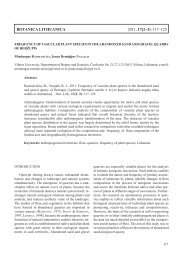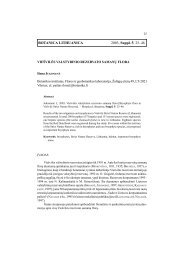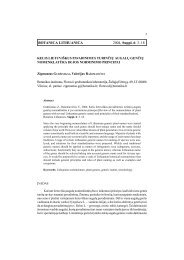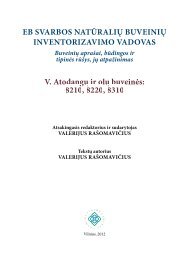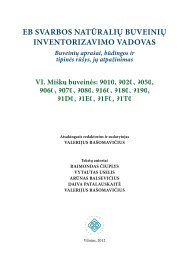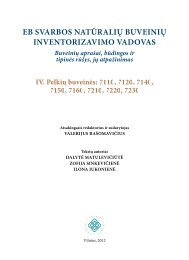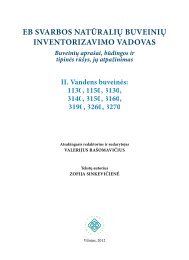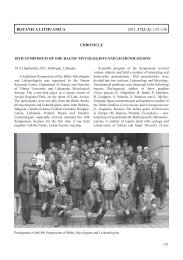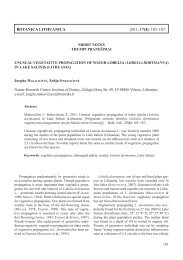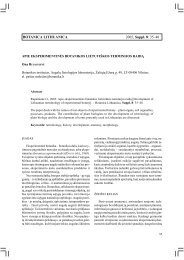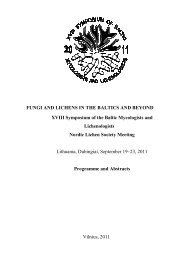BOTANICA LITHUANICA 2005, Suppl. 7: 65–75
BOTANICA LITHUANICA 2005, Suppl. 7: 65–75
BOTANICA LITHUANICA 2005, Suppl. 7: 65–75
- No tags were found...
You also want an ePaper? Increase the reach of your titles
YUMPU automatically turns print PDFs into web optimized ePapers that Google loves.
ascertained. Micromycetes Alternaria brassicae, A. pluriseptata,Chrysosporium merdarium, Fusarium solani,Fusarium sp. 1-pK, Penicillium expansum, Penicilliumsp. sv.-161-1 are able to produce toxic metabolites intensively.From grain of spring barley ‘Luokë’ and winterwheat ‘Zentos’ micromycetes were isolated, identifiedand their ability to produce deoxinivalenol and zearalenonwas tested. When micromycetes of 12 species ofthe Fusarium genus were tested, it was established thatdeoxynivalenol was produced the most intensively byFusarium sporotrichioides 4 (1.20 mg/kg) and F. equiseti6 (0.800 mg/kg), zearalenon – by F. chlamydosporum7 (0.468 mg/kg) and F. equiseti 6 (0.564 mg/kg). Themost interesting and dangerous are those strains, whichare capable of producing two or more toxic derivatives.Carrying out the screening of mycotoxin’ producentsthe thin-layer chromatography constants for secondarytoxic metabolites (T-2, nivalenol, zearalenon, altemuen,tenuazonic acid) were determined (Table 1, Table 3). Tendifferent micromycetes were detected basing on the toxinsproduced into agar of Czapek-yeast extract (CYA)and Yeast extract sacharose (YES). Using solvent systemsdescribed in the Materials and Methods, 6 derivativesflorescent under UV light from Aspergillus fumigatuswere found. Their Rf was from 0.46 to 0.91. Fusariumsporotrichioides produced 4 derivatives, which Rfwas from 0.13 to 0.89. One derivative (Rf = 0.42) wasidentified as T-2 toxin. Penicillium variabile released4 derivatives, which Rf was from 0.06 to 0.88. The derivative,which Rf = 0.87 was identified as patulin andthe derivative with Rf = 0.88 – penitrem. Fusarium poaeproduced 1 derivative with Rf = 0.87, which was identifiedas T-2 toxin. Penicillium viridicatum secreted 7derivatives, which Rf was from 0.63 to 0.89. The derivativewith Rf = 0.51 was identified as ochratoxin, andthe peripheral derivative with Rf = 0.68 – tenuazonicacid. In the extract of Fusarium tricinctum 2 derivativeswith Rf = 0.14 and 0.89 were detected. The latter derivativewas identified as T-2 toxin. Fusarium equisetiproduced 5 derivatives, which Rf was from 0.14 to 0.89.The derivative with Rf = 0.63 is close to citochalazine.In extracts of Alternaria alternata there were 7 components,one of them (Rf = 0.69) was identified as tenuazonicacid, the other one (Rf = 0.83) – sterigmatocistin,the third one (Rf = 0.63) was close to citochalazin. Trichosporiellacerebriformis produced 7 derivatives withRf from 0.06 to 0.89. The derivative with Rf 0.59 wasclose to patulin. The content of mycotoxins was determinedin wheat bread contaminated by micromycetesFusarium tricinctum, Penicillium variabile and Fusariumsp. In bread samples high amounts of T-2 toxinwere found – 0.9441 and 0.8971 mg/kg. Micromycetesof the Penicillium genus able to produce patulin, ochratoxin,penitrem, citochalazin, tenuazonic acid, sterigmatoxinand other toxins were isolated from variousfood sources (Table 6).The most active ochratoxin producers were Penicilliumgriseofulvum (= P. citreoviride), P. spinulosum,P. waksmani and P. italicum. Micromycetes capable ofproducing a wide spectrum of toxic substances of variouschemical compositions were screened and deposited topure culture collection. According to the obtained datasuch micromycetes were Penicillium expansum sv.-168-1,Penicillium sp. sv.-161-1, Fusarium solani F-08, Alternariaalternata B-230-1, A. pluriseptata B-230-3, Ulocladiumoudemansii B-230-2, Aspergillus (=Eurotium)raperi 2-Sal. Other micromycete strains were weakertoxin producers. Cladosporium chlorocephalum 3-ph,which was spread on barley grain, produced a substance(Rf = 0.89) close to sterigmatoxin. This was specific tostrains Scytalidium lignicola G-453 and Alternaria sp.M-447. It was found out that the same strains growingon different substrates produce different amounts ofmycotoxins such as deoxyvalenol (DON) and zearalenon(Table 7).Contamination of food raw material and products bymicromycetes is determined by their distribution in theenvironment; especially it is evident during storage ofgrain, vegetables and fruit. Just after the transportationof grain yield (2003–2004) to storehouses, several micromycetes– potential producers of toxic metabolites –were detected on both grain surface and inside the grain.These were the following: Alternaria alternata, Fusariumavenaceum, F. graminearum, F. poae, F. tricinctum,F. solani, F. sporotrichioides, Penicillium aurantiocandidum,P. expansum and P. funiculosum. Latercereal grain and their processed products are contaminatedmostly by Penicillium verrucosum, P. variabile,P. expansum, Aspergillus clavatus, A. niger, Drechslerasorokiniana and Rhizopus oryzae, while counts of Fusariumpoae, F. sporotrichioides and Alternaria alternatadecrease. A specific composition of micromycetes wasdetermined on seeds of rape, flax, maize and soy andthe processed products. Fungi Aspergillus niger, Fusariumoxysporum, Penicillium expansum, Alternaria alternata,Fusarium avenaceum, Rhizomucor pusillus, Aspergillusclavatus, A. versicolor, Penicillium palitans,P. roquefortii, P. viridicatum and P. verrucosum weredetected most frequently. These fungi were prevalentalso in the air of grain storehouses as well as in vegetableand fruit storehouses.According to the method of thin-layer chromatographyby FRISVALD & THRANE (2000) exogenic metabolitesproduced by micromycetes, isolated from tested72



